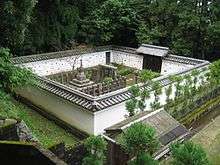Tsuki no wa no misasagi
Tsuki no wa no misasagi (月輪陵) is the name of a mausoleum in Higashiyama-ku, Kyoto used by successive generations of the Japanese Imperial Family.[1]
The tomb itself is situated in Sennyū-ji temple, which was the hereditary Buddhist temple or bodaiji (菩提寺) of the Imperial family.[2]
Notable interments
Kamakura period
Edo period

The Imperial Household Agency maintains Tsuki no wa no misasagi as the place of enshrinement and the venue for veneration of several Edo period emperors.
- 108 Emperor Go-Mizunoo.[4]
- 109 Empress Meishō.[4]
- 110 Emperor Go-Kōmyō.[4]
- 111 Emperor Go-Sai.[4]
- 112 Emperor Reigen.[4]
- 113 Emperor Higashiyama.[4]
- 114 Emperor Nakamikado.[4]
- 115 Emperor Sakuramachi.[4]
- 116 Emperor Momozono.[4]
- 117 Empress Go-Sakuramachi.[4]
- 118 Emperor Go-Momozono.[4]
In addition, this is the official misasagi for Prince Masahito, posthumously named Yōkwōin daijō-tennō, who was the eldest son of Emperor Ōgimachi and the father of Emperor Go-Yōzei.[5]
Three other Edo Period emperors are also enshrined at Nochi no tsuki no wa no Higashiyama no misasagi (後月輪東山陵).[4] The final resting places of two Empress Dowagers are also found in this Imperial tomb complex.
- 119 Emperor Kōkaku[4] and Empress Yoshiko[6]
- 120 Emperor Ninkō.[4]
- 121 Emperor Kōmei[4] and Empress Eishō.[7]
See also
Notes
- ↑ Ponsonby-Fane, Richard. (1959). The Imperial House of Japan, pp. 418-424.
- ↑ Hall, John Whitney et al. (1991). The Cambridge History of Japan: Early modern Japan, p. 383.
- 1 2 Ponsonby-Fane, Imperial House, p. 422; Sennyū-ji: Imperial mausoleum.
- 1 2 3 4 5 6 7 8 9 10 11 12 13 14 15 Ponsonby-Fane, Imperial House, p. 423.
- ↑ Ponsonby-Fane, p. 424.
- ↑ Ponsonby-Fane, Imperial House, pp. 333-334.
- ↑ Ponsonby-Fane, Imperial House, p. 335.
References
- Hall, John Whitney, James L. McClain, Marius Jansen. (1991). The Cambridge History of Japan: Early modern Japan. Cambridge: Cambridge University Press. ISBN 978-0-521-22355-3; OCLC 17483588
- Ponsonby-Fane, Richard Arthur Brabazon. (1956). Kyoto: The Old Capital of Japan, 794–1869. Kyoto: Ponsonby Memorial Society. OCLC 182637732
- __________. (1959). The Imperial House of Japan. Kyoto: Ponsonby Memorial Society. OCLC 194887